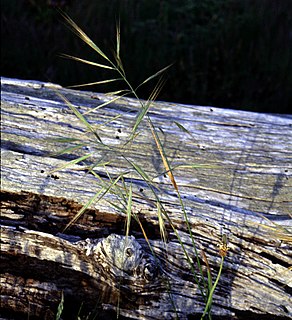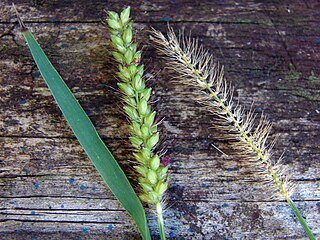
Poaceae or Gramineae is a large and nearly ubiquitous family of monocotyledonous flowering plants known as grasses, commonly referred to collectively as grass. Poaceae includes the cereal grasses, bamboos and the grasses of natural grassland and cultivated lawns and pasture. Grasses have stems that are hollow except at the nodes and narrow alternate leaves borne in two ranks. The lower part of each leaf encloses the stem, forming a leaf-sheath. With around 780 genera and around 12,000 species, Poaceae are the fifth-largest plant family, following the Asteraceae, Orchidaceae, Fabaceae and Rubiaceae.

Timothy-grass is an abundant perennial grass native to most of Europe except for the Mediterranean region. It is also known simply as timothy, meadow cat's-tail or common cat's tail. It is a member of the genus Phleum, consisting of about 15 species of annual and perennial grasses.

Alopecurus pratensis, known as the meadow foxtail or the field meadow foxtail, is a perennial grass belonging to the grass family (Poaceae). It is native to Europe and Asia.

Pennisetum is a widespread genus of plants in the grass family, native to tropical and warm temperate regions of the world. They are known commonly as fountaingrasses

A spikelet, in botany, describes the typical arrangement of grass flowers.

Alopecurus myosuroides is an annual grass, found on cultivated and waste land. It is also known as slender meadow foxtail, black-grass, twitch grass, and black twitch.

Bromus diandrus is a species of grass known by the common names great brome and "ripgut brome".

Crypsis alopecuroides is a species of grass known by the common name foxtail pricklegrass. It is native to Europe, the Middle East, and North Africa. It is also known in the western United States as a common and widespread introduced species, especially in sandy areas around water, such as lakesides. It has also been collected at shipping points near Philadelphia but has not been seen there in about a century. This is an annual grass producing mostly upright and unbranching stems, often dark in color, up to about 75 centimeters in maximum height. The green leaves are up to 12 centimeters long, sometimes waxy in texture. The inflorescence is a dense cylindrical panicle of tiny green to purple spikelets.

Cynosurus echinatus is a species of grass known by the common names bristly dogstail grass, rough dog's-tail and hedgehog dogtail. It is native to southern Europe, and it is known in the Americas and Australia as an introduced species and sometimes a noxious weed. An herbicide-resistant strain can be found growing as a weed in canola and wheat fields in Chile. This is an annual grass growing 10 to 50 centimeters tall. The inflorescence is a rounded or oval cluster or series of clusters of spikelets. The fertile spikelet has an awn up to a centimeter long. The awns clumped closely together into a tuft gives the inflorescence its bristly, hairy appearance.
Muhlenbergia andina, known by the common name foxtail muhly, is a species of grass. It is native to western North America from British Columbia to California to Texas. It grows in moist habitat such as meadows, marshes, and riparian riverbanks.

Setaria pumila is a species of grass known by many common names, including yellow foxtail, yellow bristle-grass, pigeon grass, and cattail grass. It is native to Europe, but it is known throughout the world as a common weed. It grows in lawns, sidewalks, roadsides, cultivated fields, and many other places. This annual grass grows 20 centimeters to well over a meter in height, its mostly hairless stems ranging from green to purple-tinged in color. The leaf blades are hairless on the upper surfaces, twisting, and up to 30 centimeters long. The inflorescence is a stiff, cylindrical bundle of spikelets 2 to 15 centimeters long with short, blunt bristles. The panicle may appear yellow or yellow-tinged.

Setaria verticillata is a species of grass known by the common names hooked bristlegrass, rough bristle-grass and bristly foxtail. It is native to Europe, but it is known on most continents as an introduced species and often a noxious weed. It is a hardy bunchgrass which grows in many types of urban, cultivated, and disturbed habitat. It is a weed of many types of agricultural crops, growing in vineyards and fields. Herbicide-resistant strains have been noted.

Setaria viridis is a species of grass known by many common names, including green foxtail, green bristlegrass, and wild foxtail millet. It is sometimes considered a subspecies of Setaria italica. It is native to Eurasia, but it is known on most continents as an introduced species and is closely related to Setaria faberi, a noxious weed. It is a hardy grass which grows in many types of urban, cultivated, and disturbed habitat, including vacant lots, sidewalks, railroads, lawns, and at the margins of fields. It is the wild antecedent of the crop foxtail millet. In Korea, the flower blooms in midsummer (July–August).

Setaria parviflora is a species of grass known by the common names marsh bristlegrass, knotroot bristle-grass, bristly foxtail and yellow bristlegrass. It is native to North America, including Mexico and the United States from California to the East Coast, Central America and the West Indies, and South America.

Cransford Meadow is a 4.6 hectare biological Site of Special Scientific Interest south of Cransford in Suffolk.




















